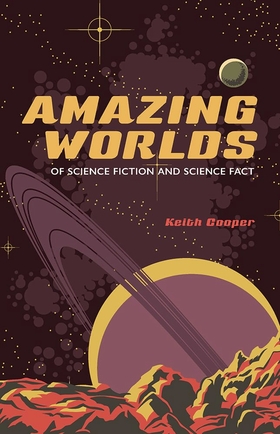Centauri Dreams
Imagining and Planning Interstellar Exploration
Cosmology: Shelter from the Storm
I had thought while the power was out this past week that I would like to write about cosmology when it came back. That’s because there’s nothing like a prolonged power outage to adjust your perspective. The big picture beckons. In my case, it was thinking about how trivial being out of power was compared to those who had lost so much more in the wake of the recent hurricane.
So thinking about the cosmos became my shelter from the storm. I appreciated the emails from so many of you, but aside from a major chunk of tree that landed on the roof, we did just fine. In fact, it was deeply moving to see people from the neighborhood — some I knew, some I only recognized — turn up to get up on the roof and move that tree. I’m always reminded to do more for the people around me when I see something like this, and apprehensive that my resolution to do so all too often gets put aside as normal life returns.
The Universe We Can See
Reading by candlelight really is wonderful, and I ask myself why I don’t do it more often. There is something about that soft, flickering light on a well-printed page. And I found reading about cosmology by candlelight was especially pleasing, a way of connecting to a past way of life that had its own conceptions about the cosmos. One thing I read was my notes from work just received when the power went, a paper on galactic structure I fortunately printed just in time.
The conclusion of this one is straightforward: There are at least 10 times as many galaxies in the observable universe as previously thought. Christopher Conselice (University of Nottingham, UK) led an international team that produced this result. I was reading about it in a room full of candles and thinking about room after room of candles stretching out into infinity.
That homely thought weds the prosaic and the vast, sort of the way Douglas Adams did in his famous line on the size of the universe in The Hitchhiker’s Guide to the Galaxy:
“Space is big. You just won’t believe how vastly, hugely, mind-bogglingly big it is. I mean, you may think it’s a long way down the road to the chemist’s, but that’s just peanuts to space.”
I’m sure you’re familiar with the line, but it still raises a chuckle. And this team’s findings cause yet another shift in perspective. Thus Conselice:
“It boggles the mind that over 90% of the galaxies in the Universe have yet to be studied. Who knows what interesting properties we will find when we observe these galaxies with the next generation of telescopes.”
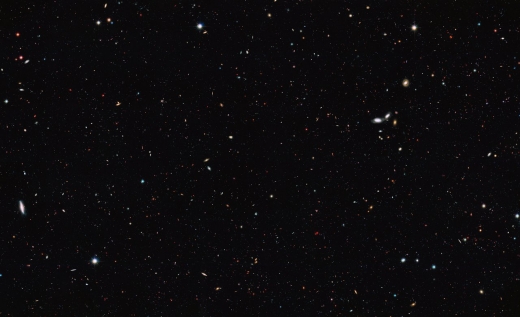
Image: The GOODS South Field (Great Observatories Origins Deep Survey). GOODS draws on observations from the Spitzer, Hubble and Chandra observatories as well as the European Space Agency’s Herschel and XMM-Newton, along with ground-based facilities, to survey the distant universe across the electromagnetic spectrum. Credit: GOODS/Conselice et al.
Before this, we relied on such measures as the Hubble Deep Field images from the 1990s, which helped us arrive at an estimate of between 100 and 200 billion galaxies in the observable universe. Conselice and team studied the matter using Hubble imagery as well as other published data to create a 3D view, estimating the number of galaxies at various times in the history of the cosmos. Their mathematical models pointed to the result, that we have not been able to see most of the galaxies that are out there in our cosmological horizon.
Moreover, the work offers an interesting perspective on galaxies throughout time, one showing how their numbers have changed as the universe evolved. The paper explains that the total number density of galaxies in the universe declines with time:
[The] total number density… declines by a factor of 10 within the first 2 Gyr of the universe’s history, and a further reduction at later times. This decline may further level off between redshifts of z = 1 and z = 2. The star formation rate during this time is also very high for all galaxies, which should in principle bring galaxies which were below our stellar mass limit into our sample at later times. This would naturally increase the number of galaxies over time, but we see the opposite. This is likely due to merging and/or accretion of galaxies when they fall into clusters which are later destroyed through tidal effects, as no other method can reduce the number of galaxies above a given mass threshold.
So what is known as the ‘top-down formation of structure’ in the universe is supported by this work. Most of the galaxies in the first few billion years of the universe were similar in mass to the satellite galaxies we see surrounding the Milky Way. Galactic mergers reduce the total number. And although Conselice and colleagues show us that there are so many galaxies that almost every point in the sky contains part of one, most of these galaxies are invisible not just to the human eye but to our best telescopes.
If that rings a bell, it’s because we’re homing in on Olbers’ paradox, the idea that the darkness of the night sky is in contradiction to the assumption of an infinite universe filled with stars (based on the work of the German astronomer Heinrich Wilhelm Matthias Olbers, 1758-1840). Why is the night sky as dark as it is? I won’t get into the details on dust and gas absorption of light that the paper offers, but will simply quote the finding from the Conselice paper:
It would… appear that the solution to the strict interpretation of Olbers’ paradox, as an optical light detection problem, is a combination of nearly all possible solutions – redshifting effects, the finite age and size of the universe, and through absorption.
The paper is Conselice et al., “The Evolution of Galaxy Number Density at z < 8 and its Implications,” to be published in the Astrophysical Journal. Preprint here.

Working in the Dark
Hurricane Matthew’s effects continue to be felt in the form of flooding, power outages and downed trees. I’m now told not to expect power for 4-6 days. The situation obviously impacts my ability to post here. I’ll try to keep up with comment moderation when possible. Will get things back to normal whenever the lights come back on.
Spiral Density Waves: Clue to Planet Formation?
Have a look at the spiral of pinwheeling dust that can be seen around the young star Elias 2-27. We’re looking at gravitational perturbations in a protoplanetary disk that, as this National Radio Astronomy Observatory news release says, mimic the vast arms we expect in a spiral galaxy. But here we’re looking at a process with implications for planet formation, one that draws on data from the Atacama Large Millimeter/submillimeter Array (ALMA). This is the first time a spiral density wave has been detected in a protoplanetary disk’s planet formation areas.
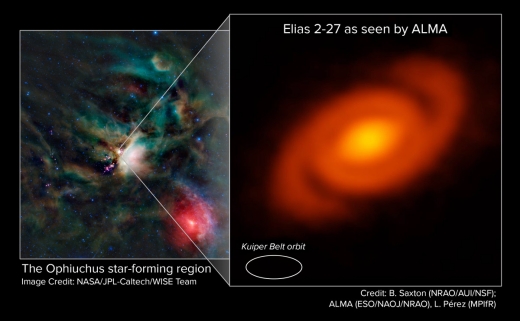
Image: ALMA peered into the Ophiuchus star-forming region to study the protoplanetary disk around the young star Elias 2-27. Astronomers discovered a striking spiral pattern in the disk. This feature is the product of density waves – gravitational perturbations in the disk. Credit: L. Pérez (MPIfR), B. Saxton (NRAO/AUI/NSF), ALMA (ESO/NAOJ/NRAO), NASA/JPL Caltech/WISE Team.
Some 450 light years from Earth in the Ophiuchus star-forming region, Elias 2-27 is about half the mass of the Sun, though its protoplanetary disk is massive. Although the young star (about a million years old, according to current estimates) is shrouded by the molecular cloud from which it grew, ALMA was able to peer into the mid-plane of the disk to identify the spiral density waves. The spiral arms extend as much as 10 billion kilometers away from the host star.
All this catches the eye because while we can account for star formation from the collapse of gas and dust under the influence of gravity, we need a mechanism to keep enough material from falling into the protostar to ensure that it doesn’t spin up enough to shred itself. The protostellar disk projects angular momentum outward, and is where we can expect planets to form. But standard core accretion models have problems explaining the formation of planets 20 to 30 AU out, where the disk may not be dense enough to allow the process to be efficient.
Gravitational instabilities in the outer disk, however, can produce the kind of dense spiral arms we see here, with new material being pushed out into regions far from the star and collapsing under its own gravity to begin planet formation. Andrea Isella (Rice University) explains:
“We don’t completely understand how planets form, but we suspect there are two ways: Either small particles stick together until they form something like the Earth or Mars, or accreting gas forms a planet like Saturn or Jupiter. But this process works only very close to the star, within a few astronomical units (roughly the distance from the Sun to the Earth), because that’s where all the material is, and it has to have enough density… If a disk is massive enough to be gravitationally unstable, a spiral will form naturally.”
Thus the spiral arms of Elias 2-27 may be the manifestation of an instability that gives birth to a particular kind of exoplanet. Near to the star, the ALMA observations found a flattened dust disk that extends out beyond 30 AU, followed by a narrow band of sharply diminished dust that may indicate a planet in formation. The spiral arms extend outward from the edge of this gap in the disk. Lead author Laura Pérez (Max Planck Institute for Radio Astronomy) notes that an upcoming program will use ALMA data to home in on similar protoplanetary disks as we try to find out whether Elias 2-27’s spiral density waves actually do reveal planet(s) in formation.
The paper is Pérez et al., “Spiral density waves in a young protoplanetary disk,” Science Vol. 353, Issue 6307 (30 September 2016), pp. 1519-1521 (abstract). A Rice University news release is also available.

Detecting Long-Period Planets & Stellar Companions
Spotting planets a long way from their stars is no easy proposition when you’re using radial velocity methods. The idea is to track the minute movement of the star as it is affected by an orbiting planet, which shows up as a Doppler shift in the data. What we’re actually seeing is the star and planet orbiting the center of gravity, an indirect method of detection that observes not the planet itself but the effects of the planet as it produces this variation in radial velocity.
The first exoplanets were detected this way, and the method has continued to produce new discoveries. But as a planet’s distance from its star increases, radial velocity becomes tricky to use. Now observation times become extended as the planet completes its longer orbit. We face the same issue with the transit method, which charts the drop in brightness as a planet moves across the face of its star as seen from Earth. Here, too, planets in distant orbits around their star are hard to detect because of the lengthy period of time between individual transits.
Because of these issues, we have little data on the occurrence rate of planets in wide orbits, and that is a problem for analyzing planet formation theories like core accretion, gravitational disk instability and planet migration. The long-term radial velocity data of a host star with a companion object beyond 10 AU shows an almost linear trend over a short observing period. Detection of such a trend is not in itself enough to identify the source of the RV signal.
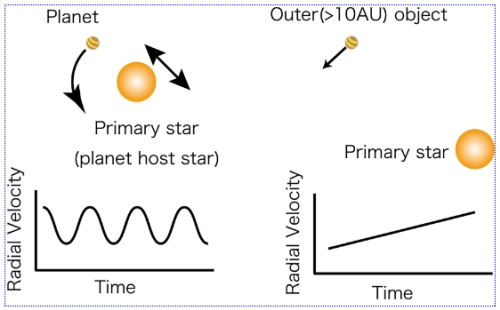
Image: Periodic change in the radial velocity of the primary star shown left is the strong signature of a planet. When the companion object is far way (farther than 10 AU), the orbital period is so long that the radial velocity shows a linear change, as shown in the right panel. (Credit: NAOJ).
Researchers from the Tokyo Institute of Technology have been trying to solve this problem by combining radial velocity methods with direct imaging. With the latter, the planet detection actually becomes easier as the distance between star and planet widens, because the light of the companion object is not swamped by proximity to the host star. The Tokyo team, using an instrument at Okayama Astrophysical Observatory (NAOJ) has targeted stars 1.5 to 5 times as massive as the Sun, looking not just for long period planets but also companion stars.
A long-term radial velocity trend flags such objects, but it’s the follow-up with direct imaging (in this case using the HiCIAO imager at the Subaru Telescope) that has paid off in an analysis of six intermediate-mass giant stars. All six of these stars showed a long-term radial velocity trend. The question thus becomes, is the source of the trend a companion star or a planet?
HiCIAO is a coronagraph that masks the light of the primary star to allow detection of fainter objects. Three of the observed stars — ? Hydra, HD 5608, and HS 109272 — show companion stars in this analysis, while around three others — ? Draconis, 18 Delphinus, and HD 14067 — companion objects more massive than 60 Jupiter masses can be excluded. The latter are considered candidates for hosting brown dwarfs, while 18 Delphinus is the most likely prospect for hosting a high-mass planet (~ 10-50 AU) that is below the current detection limit.

Image: Objects in the yellow circle were detected by the current study. White circles or round squares show the position of the primary star. The primary was masked during the observation to help the detection of the fainter objects nearby. (Credit: NAOJ)
Combining radial velocity with direct imaging has allowed the team to confirm that the companion objects they found were the cause of the long-term trend in the RV data. On a broader level, these methods may help us understand the distribution of planets around stars more massive than the Sun, as the paper on this work notes:
At Okayama Astrophysical Observatory (OAO), an RV survey targeting intermediate-mass giants (1.5–5 M?) has been conducted for over a decade (e.g., Sato et al. 2003). Sato et al. (2008) found that there is a difference between orbits of planets around intermediate-mass stars and around lower-mass FGK stars. Most planets around intermediate-mass stars have a semi-major axis larger than 0.6 AU, while FGK stars have shorter-period planets. Hence, it was suggested that the orbital distribution of exoplanets around intermediate-mass stars is different from that around solar-type stars.
Is the suggestion valid, or simply the result of our limited datasets? The paper continues:
In addition, the OAO survey detected long-term RV trends in several targets, which indicates the presence of distant companions around them… Identifying the companions that generate the RV trend can improve our knowledge of exoplanet populations for intermediate-mass stars, which are not well understood compared to solar-type stars.
This is not the only study that has combined direct imaging and radial velocity trends. In fact, a project called TRENDS (TaRgetting bENchmark objects with Doppler Spectroscopy), led by Justin Crepp (Notre Dame) has detected three low-mass stellar companions using these methods, along with a white dwarf and a brown dwarf companion, working with data on host stars ranging from F-class down to M-dwarfs. Clearly, direct imaging can be a benefit as we try to work out the source of RV trends that point to the existence of a distant companion.
The paper is Ryu et al., “High-contrast Imaging of Intermediate-mass Giants with Long-term Radial Velocity Trends,” Astrophysical Journal Vol. 825, No. 2 (12 July 2016). Abstract / preprint.

On Outer System Oceans
Back in the days when I was reading Poul Anderson’s The Snows of Ganymede and thought of the moons of Jupiter as icy wastelands, I never would have dreamed there could be an ocean below their surfaces. But now we have oceans proliferating. Ganymede’s may contain more water than all Earth’s oceans, while Callisto is also in the mix, and we’ve known about Europa for some time now. At Saturn, the case for an ocean inside Titan seems strong, while Enceladus continues to spark mission proposals to study its frequent geysers.
If you’re a Centauri Dreams regular, you know that we’ve talked about Pluto’s oceanic possibilities for some time, now strengthened in new work from Brandon Johnson (Brown University). Johnson and colleagues have modeled an ocean layer on Pluto more than 100 kilometers thick, with a salt content more or less like that of the Dead Sea on Earth. Johnson focused on Sputnik Planum, the 900-kilometer basin that comprises part of the heart-shaped feature we all learned to recognize during last summer’s New Horizons flyby.
The work is helpful because unlike previous studies, it puts constraints on the depth of the ocean and offers information about its composition. Sputnik Planum, as it turns out, sits exactly on the tidal axis linking tidally-locked Charon with Pluto, suggesting that the area has a positive mass anomaly; i.e., there is more mass here than the average for Pluto’s crust.
Thus Charon’s gravity would eventually pull this higher-mass area into the alignment we see. A large impact, like the one that created Sputnik Planum, would eventually be filled with liquid water, and in Johnson’s scenario, nitrogen ice deposited later would tip the scales, creating the positive mass anomaly. “This scenario, says Johnson, “requires a liquid ocean.” And of the various thicknesses of the water layers modeled, 100 kilometers works out best at creating the features we see at Sputnik Planum.
Usefully, the team’s computer models showed that the thickness of the ocean layer could be tied directly to the production of the mass anomaly, which also turns out to be sensitive to the salinity of the water, affecting the water’s density. We can tell a lot from this impact of an object 200 kilometers across or larger and its effects upon an ocean with a salinity of about 30 percent.
“What this tells us is that if Sputnik Planum is indeed a positive mass anomaly —and it appears as though it is — this ocean layer of at least 100 kilometers has to be there,” Johnson says. “It’s pretty amazing to me that you have this body so far out in the solar system that still may have liquid water.”
The Case for Dione
Now we have word of yet another possible ocean, this one on Saturn’s moon Dione. Mikael Beuthe (Royal Observatory of Belgium) and team have been modeling the icy shells of Enceladus and Dione, using gravity data from Cassini flybys. The models study the shells of both moons as global icebergs immersed in water — here surface peaks are held up by a large mass under the water. The approach has not previously proven effective in modeling Enceladus, for it produces a thick crust for the moon that is inconsistent with our observations.
But isostasy, the equilibrium in parts of the Earth’s crust, can be similarly modeled, as blocks floating on the underlying mantle, which rises and falls as material is added or removed. What the researchers have done is to add a new wrinkle:
“As an additional principle, we assumed that the icy crust can stand only the minimum amount of tension or compression necessary to maintain surface landforms,” says Beuthe. “More stress would break the crust down to pieces.”
This revised model works well at producing an ocean for Enceladus under a thinner crust than previous models, with water close enough to the surface to produce the famous geysers at the south pole. The model is also consistent with the libration of Enceladus in its orbit, oscillations that would be smaller if the moon had a thicker crust. Under the same model, Dione is revealed to have a much thicker crust covering a deep ocean between the crust and the moon’s core.
The Cassini data thus become consistent with an ocean about 100 kilometers below the surface of Dione, an ocean perhaps tens of kilometers deep surrounding a large, rocky core. We may be able to test this prediction with future spacecraft in the Saturn system, which may be able to measure the libration of Dione, an oscillation the researchers believe would be well below the detection capabilities of Cassini, but a useful marker as evidence of the subsurface ocean.
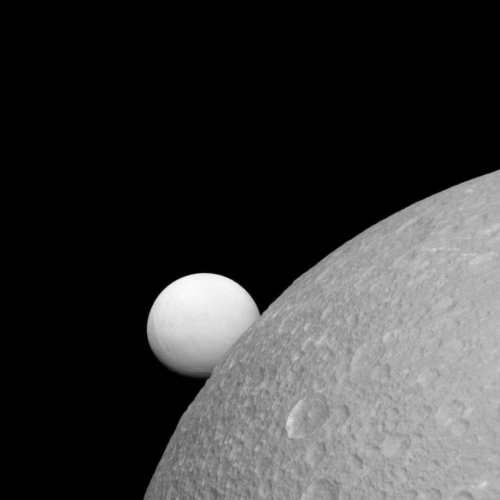
Image: Dione with Enceladus in the background. This image was taken by the Cassini spacecraft on 8 September 2015. Credit: NASA/JPL-Caltech/Space Science Institute.
And what of other outer system objects? From the paper:
Beyond Enceladus and Dione, our new take on isostasy is applicable to large icy satellites
with global oceans, such as Europa [Nimmo et al., 2007b], Titan [Nimmo and Bills,2010], and particularly Ganymede whose gravity and shape will be measured by the JUICE mission. According to Park et al. [2016], gravity and shape data from the Dawn mission suggest isostasy on Ceres, but the case is far from clear because compensation does not occur for all gravity components. Finally, isostasy plays a crucial role in understanding the long-wavelength gravity and shape as well as estimating the crust thickness of the planets Mars [Wieczorek and Zuber , 2004], Venus [James et al., 2013], and Mercury [Perry et al., 2015]. Thanks to the simultaneous availability of gravity/shape and libration data, Enceladus’s case constitutes the first validation of planetary-scale isostasy.
The paper is Beuthe et al., “Enceladus’ and Dione’s floating ice shells supported by minimum stress isostasy,” published online by Geophysical Research Letters 28 September 2016 (abstract / preprint). The paper on Pluto’s ocean is Johnson et al., “Formation of the Sputnik Planum basin and the thickness of Pluto’s subsurface ocean,” Geophysical Research Letters 19 September 2016 (abstract).

System Evolution: Delving into Brown Dwarf Disks
We’ve seen circumstellar disks around numerous stars, significant because it is from such disks that planets are formed, and we would like to know a good deal more about how this process works. Now we have word of planet-forming disks around several low-mass objects that fit into the brown dwarf range, and one small star about a tenth the mass of the Sun. With the brown dwarfs, we’re working with objects small enough to be at the boundary between planet and star.
The work is led by Anne Boucher (Université de Montréal), whose team drew photometric data from the Two-Micron All-Sky Survey (2MASS) and the Wide-field Infrared Survey Explorer (WISE) mission, allowing the detection of the objects at infrared wavelengths. Boucher notes the strong attraction such objects hold for astronomers:
“Finding disks in low-mass systems is really interesting to us, because objects that exist at the lower limit of what defines a star and that still have disks that indicate planet formation can tell us a lot about both stellar and planetary evolution.”
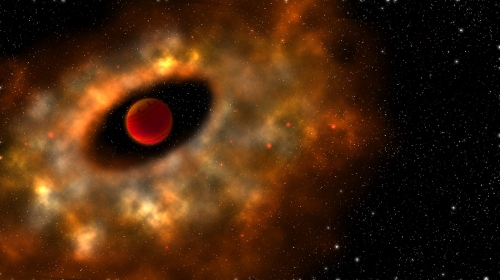
Image: An artist’s conception of a planet-forming disk around a brown dwarf. Credit: Robin Dienel.
But let’s pause for a moment on the nature of the disks themselves. Dusty debris disks are considered to be signs of past planet formation, while gas-rich primordial disks mark the presence of active planet formation and accretion into the host star. Because disks can be detected by the presence of excess infrared, beyond what we would expect from the star by itself, we can use infrared observations to measure the differences in thermal emission from one infant system to another, showing us a range of disks at various stages of their evolution.
Thus we get massive primordial disks that are gas-rich and dense around younger systems, while dusty debris disks are colder and more depleted in gas, marking the remnants of planetary system formation even as they are replenished by the collisions of small objects in the system. These can last up to 100 million years; they’re colder and observable in the mid-infrared (primordial disks produce a strong signature in the near-infrared). We also see so-called ‘transition’ disks with an inner region depleted of dust, and an outer region still rich in it.
What Boucher and colleagues have been looking at are three objects ranging from 13 to 19 Jupiter masses, and a fourth of between 101 and 138 Jupiter masses. The paper makes the case that all four disk candidate stars are members of stellar associations — the TW Hydra, Columba, and Tucana-Horologium associations — allowing the researchers to draw conclusions about their age. A stellar association is a large grouping of stars similar in spectral type and origin, grouped more loosely than open or globular-type star clusters. These are young stars that have not had time to move any great distance from their place of formation.
The four disks are all thought to be in the planet-forming phase, none of them having attained the age of a dusty debris disk. Even so, two of these objects appear older — at between 42 and 45 million years — than we would normally associate with an active disk system. From the paper:
Disk temperatures and fractional luminosities were determined from this analysis. Their values indicate that the new disks are likely transitional or primordial. The spectral types of these new disk hosts are late (M4.5 to L0?), and correspond to low-mass BDs (13 ? 19 and 101 ? 138MJup) of young ages (? 7 ? 13 and ? 38 ? 49Myr). These four systems join a relatively small sample of low-mass objects known to harbor a circumstellar disk. There is still a lot to learn about primordial and (pre-)transitional disks around low-mass stars, and these four new candidates could play an important role to shed light on the formation and evolution processes of stars and planetary systems.
Also in question is the fraction of brown dwarfs that have developed planetary systems. Finding debris disks around young objects like these is one way into the problem, for we can watch the process of planet formation unfold around objects of different ages. Bear in mind as well that their lower luminosity means objects like these could be interesting targets for exoplanet searches using direct imaging methods. All four of the new disk candidates should likewise be prime candidates, the paper suggests, for the Atacama Large Millimeter Array.
The paper is Boucher et al., “BANYAN. VIII. New Low-Mass Stars and Brown Dwarfs with Candidate Circumstellar Disks,” accepted at The Astrophysical Journal (preprint).

